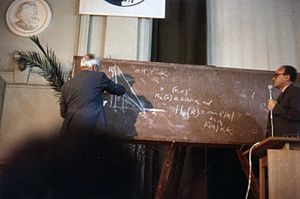Kolmogorov Structure Function
In 1973, Andrey Kolmogorov proposed a non-probabilistic approach to statistics and model selection.
Let each datum be a finite binary string and a model be a finite set of binary strings. Consider model classes consisting of models of given maximal Kolmogorov complexity. The Kolmogorov structure function of an individual data string expresses the relation between the complexity level constraint on a model class and the least log-cardinality of a model in the class containing the data. The structure function determines all stochastic properties of the individual data string: for every constrained model class it determines the individual best-fitting model in the class irrespective of whether the true model is in the model class considered or not. In the classical case we talk about a set of data with a probability distribution, and the properties are those of the expectations. In contrast, here we deal with individual data strings and the properties of the individual string focused on. In this setting, a property holds with certainty rather than with high probability as in the classical case. The Kolmogorov structure function precisely quantifies the goodness-of-fit of an individual model with respect to individual data.
The Kolmogorov structure function is used in the algorithmic information theory, also known as the theory of Kolmogorov complexity, for describing the structure of a string by use of models of increasing complexity.
Kolmogorov's definition

The structure function was originally proposed by Kolmogorov in 1973 at a Soviet Information Theory symposium in Tallinn, but these results were not published p. 182. But the results were announced in in 1974, the only written record by Kolmogorov himself. One of his last scientific statements is (translated from the original Russian by L.A. Levin):
To each constructive object corresponds a function
of a natural number k—the log of minimal cardinality of x-containing sets that allow definitions of complexity at most k. If the element x itself allows a simple definition, then the function
drops to 0 even for small k. Lacking such definition, the element is "random" in a negative sense. But it is positively "probabilistically random" only when function
having taken the value
at a relatively small
, then changes approximately as
.
— Kolmogorov, announcement cited above
Contemporary definition
It is discussed in Cover and Thomas. It is extensively studied in Vereshchagin and Vitányi where also the main properties are resolved. The Kolmogorov structure function can be written as
where 















The algorithmic sufficient statistic
We define a set 

.
The function 
.
It is approached to within a constant distance by the graph of 









.
That is, the two-part description of 






,

 and minimal sufficient statistic.
and minimal sufficient statistic. using straightforward inequalities and the sufficiency property, we find that 





















With respect to the picture: The MDL structure function 












Selection of properties
Within the constraints that the graph goes down at an angle of at least 45 degrees, that it starts at n and ends approximately at 

Main property
It is proved that at each level 


The MDL variant
The Minimum description length (MDL) function: The length of the minimal two-part code for x consisting of the model cost K(S) and the length of the index of x in S, in the model class of sets of given maximal Kolmogorov complexity 

where 
Main property
It is proved that at each level 

Application in statistics
The mathematics developed above were taken as the foundation of MDL by its inventor Jorma Rissanen.
Probability models
For every computable probability distribution 
.
For example, if 




where x is a binary string of length n with 
















Main property
It is proved that at each level 



The MDL variant and probability models
The MDL function: The length of the minimal two-part code for x consisting of the model cost K(P) and the length of 


where 
Main property
It is proved that at each level 

Extension to rate distortion and denoising
It turns out that the approach can be extended to a theory of rate distortion of individual finite sequences and denoising of individual finite sequences using Kolmogorov complexity. Experiments using real compressor programs have been carried out with success. Here the assumption is that for natural data the Kolmogorov complexity is not far from the length of a compressed version using a good compressor.
References
Literature
- Cover, T.M.; P. Gacs; R.M. Gray (1989). "Kolmogorov's contributions to Information Theory and Algorithmic Complexity". Annals of Probability. 17 (3): 840–865. doi:10.1214/aop/1176991250. JSTOR 2244387.
- Kolmogorov, A. N.; Uspenskii, V. A. (1 January 1987). "Algorithms and Randomness". Theory of Probability and Its Applications. 32 (3): 389–412. doi:10.1137/1132060.
- Li, M., Vitányi, P.M.B. (2008). An introduction to Kolmogorov complexity and its applications (3rd ed.). New York: Springer. ISBN 978-0387339986.
{{cite book}}: CS1 maint: multiple names: authors list (link), Especially pp. 401–431 about the Kolmogorov structure function, and pp. 613–629 about rate distortion and denoising of individual sequences. - Shen, A. (1 April 1999). "Discussion on Kolmogorov Complexity and Statistical Analysis". The Computer Journal. 42 (4): 340–342. doi:10.1093/comjnl/42.4.340.
- V'yugin, V.V. (1987). "On Randomness Defect of a Finite Object Relative to Measures with Given Complexity Bounds". Theory of Probability and Its Applications. 32 (3): 508–512. doi:10.1137/1132071.
- V'yugin, V. V. (1 April 1999). "Algorithmic Complexity and Stochastic Properties of Finite Binary Sequences". The Computer Journal. 42 (4): 294–317. doi:10.1093/comjnl/42.4.294.
This article uses material from the Wikipedia English article Kolmogorov structure function, which is released under the Creative Commons Attribution-ShareAlike 3.0 license ("CC BY-SA 3.0"); additional terms may apply (view authors). Content is available under CC BY-SA 4.0 unless otherwise noted. Images, videos and audio are available under their respective licenses.
®Wikipedia is a registered trademark of the Wiki Foundation, Inc. Wiki English (DUHOCTRUNGQUOC.VN) is an independent company and has no affiliation with Wiki Foundation.



